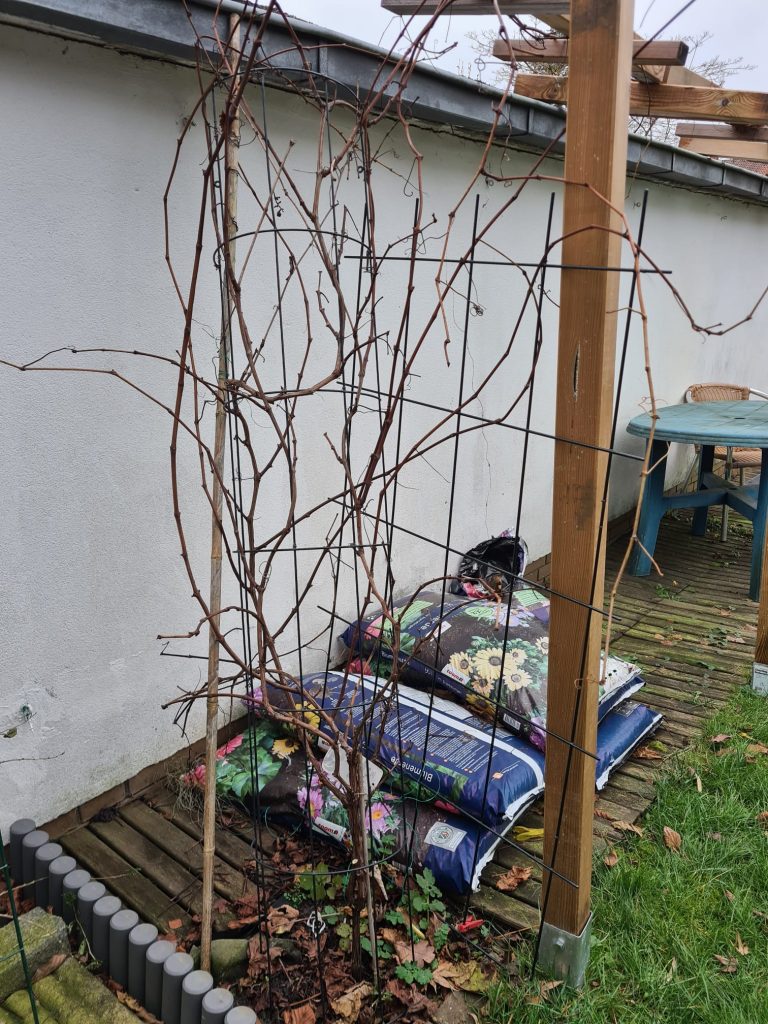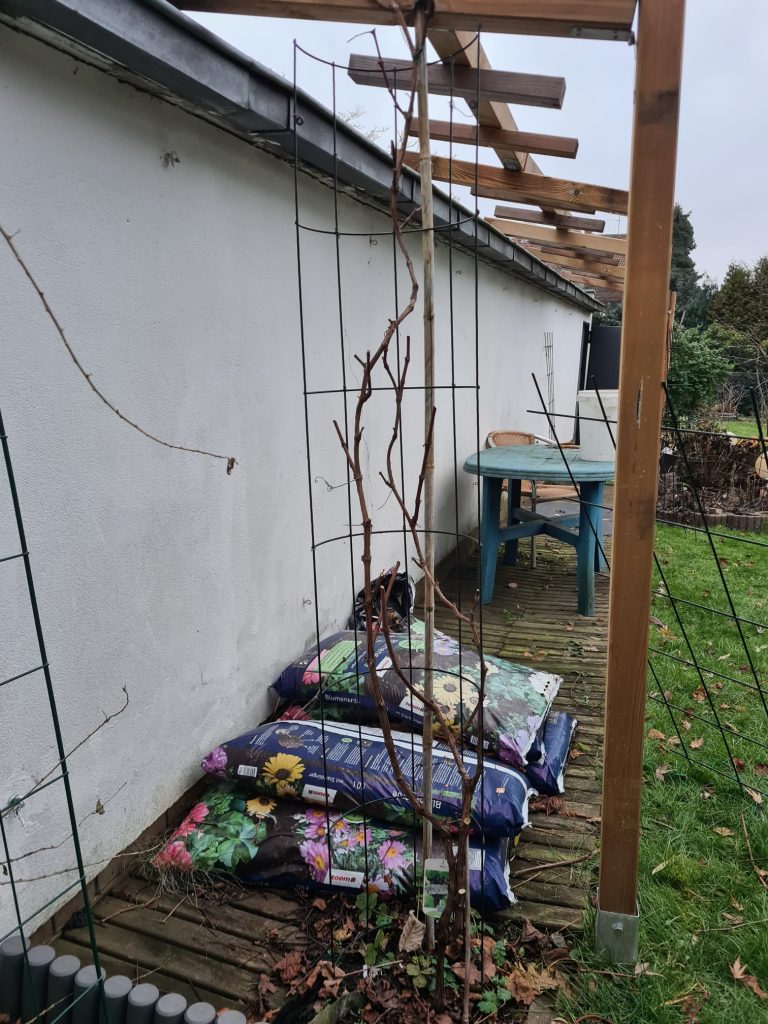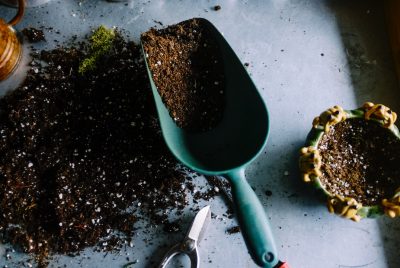Grape Vines Training and Pruning
Welcome to the fascinating world of grape vines pruning and training, where winter becomes the canvas for nurturing vibrant and fruitful grape vines. As a dedicated enthusiast and advisor, I’m excited to guide you through the nuances of this horticultural art, first learning to train your young grapevines in their first three years, then learning to prune your mature grapevines, focusing on the two primary techniques: cane pruning and spur pruning. At the beginning, it may seem daunting to prune your grape vines. However, this step is very essential to ensure that your grape vines remain healthy and ready to produce flowers and fruits in the coming season.
Grape Vine Training: Essential Early Years
Training grapevines during their early years is a crucial aspect of vineyard management. The goal is to establish a strong framework (especially having a strong healthy main trunk!), encourage healthy growth, and set the stage for optimal fruit production in subsequent years. There are numerous resources such as books and online website dedicated to grape training. However, if you are a beginning in grape training, here are some general information on grape training from the first to the third year, to get you started:
First Year: Establishment and Basic Training
1. Planting:
- Choose a well-drained site with sufficient sunlight.
- Dig a hole large enough to accommodate the roots without bending or crowding.
- Plant the grapevine, ensuring the graft union (if applicable) is above the soil line.
2. Initial Pruning:
- In the winter, prune back the vine to a single, strong cane with 2-3 buds.
- Remove any lateral shoots.
3. Stake or Trellis Installation:
- Provide support for the young vine using a stake or small trellis.
- Tie the main shoot loosely to the support to encourage upward growth.
4. Training System:
- Choose a training system suitable for your location (e.g., Vertical Shoot Positioning, High Cordon).
- Early decisions influence the long-term structure of the vine.
5. Weed Control and Mulching:
- Keep the area around the vine free of weeds.
- Apply a layer of mulch to conserve moisture and control weed growth.
6. Watering:
- Water the vine regularly, especially during dry periods.
- Ensure consistent soil moisture without waterlogging.
Second Year: Developing Structure
1. Pruning for Structure:
- Select a few strong canes and remove the rest.
- Prune to encourage the development of a primary framework.
- Leave 2-3 buds on each selected cane.
2. Trellis Adjustment:
- Adjust the trellis to accommodate the developing structure of the vine.
- Secure the canes to the trellis, promoting horizontal growth.
3. Remove Lateral Shoots:
- Pinch or prune lateral shoots that emerge along the main canes.
- Focus on directing energy towards the primary framework.
4. Fertilization:
- Apply a balanced fertilizer to support healthy growth.
- Adjust based on soil test results and vine needs.
5. Disease and Pest Management:
- Monitor for signs of diseases and pests.
- Take preventive measures as needed.
Third Year: Refinement and Fruit Development
1. Finalize Structure:
- Continue refining the vine’s structure by selecting the most vigorous and well-placed shoots.
- Prune to achieve the desired number of canes and spurs.
2. Fruit Cluster Management:
- Allow some lateral shoots to develop into fruitful canes.
- Remove excessive clusters to balance the vine’s vigor and promote quality fruit.
3. Continued Disease and Pest Management:
- Regularly inspect the vine for diseases and pests.
- Implement control measures as necessary.
4. Training for Canopy Management:
- Train shoots to fill the trellis space, creating a balanced canopy.
- Optimize sunlight exposure to grape clusters.
Understanding the Winter Pruning Ritual
Winter is the opportune season for pruning grape vines, a practice that rejuvenates the plant and sets the stage for a robust growing season. Pruning grape vines in winter is a crucial horticultural practice with several benefits that contribute to the overall health and productivity of the vines. Here are key reasons why winter pruning is necessary:
Dormancy Period:
Optimal Timing: During winter, grape vines are in a state of dormancy, meaning they are not actively growing. Pruning during this period minimizes the risk of stressing the plant, as it is less vulnerable to disease and environmental factors.
Promoting Healthy Growth:
Resource Allocation: Winter pruning allows for the removal of excess and unproductive growth, directing the plant’s energy to the most vital parts. This ensures that the vine allocates its resources efficiently, promoting robust and healthy growth when the growing season begins.
Disease Prevention:
Reducing Disease Spread: Pruning in winter helps prevent the spread of diseases. The removal of dead or diseased wood eliminates potential sources of infection, creating a healthier environment for the vine.
Enhancing Sunlight Exposure:
Sunlight Penetration: Pruning helps open up the canopy, allowing sunlight to reach the inner parts of the vine. This exposure is crucial for photosynthesis and the development of quality grapes.
Facilitating Air Circulation:
Preventing Fungal Issues: Proper air circulation is essential to prevent the development of fungal diseases. Winter pruning reduces the density of the foliage, improving air movement and reducing the risk of diseases like powdery mildew.
Structural Integrity:
Maintaining Vine Structure: Pruning is a way to shape and maintain the overall structure of the vine. It helps control the size and shape of the vine, preventing overcrowding and ensuring that each part receives adequate resources.
Facilitating Harvesting and Pest Control:
Ease of Harvesting: Well-pruned vines make it easier to harvest grapes. The removal of excessive foliage and shoots provides better access to the fruit, simplifying the harvesting process.
Pest Control: Pruning helps in managing pests by reducing hiding places and optimizing conditions for natural predators of vineyard pests.
Enhancing Fruit Quality:
Fruit Concentration: By directing the vine’s energy to a controlled number of canes or spurs, pruning contributes to concentrated fruit production. This concentration often results in higher-quality grapes.
Training for Desired Growth:
Training System Effectiveness: Winter pruning is an integral part of training grape vines according to a specific system, such as vertical shoot positioning or other trellising methods. It shapes the vine for efficient management and optimal grape production.
Let’s delve into the specifics of two prominent pruning methods: cane pruning and spur pruning.
Cane Pruning: A Methodical Approach
Cane pruning or the Guyot Method involves selecting and preserving one or two mature canes while removing the rest. It is commonly used in vineyards or to train a grapevine growing along a house facade. Green shoots become woody in the dormant season and will produce fruitful buds for the next season and they will be roughly one-year-old in the next growing season. Here’s a step-by-step guide:
Step 1: Assessing the Vines
Survey the vine and identify mature canes, typically those with a pencil-like thickness and well-spaced buds. Do not confuse one-year-old canes with the old canes. One-year-old grapevines are light brown and if you lightly scratch the surface, it will reveal the green shoot underneath.
Step 2: Selecting the Canes
Choose one or two canes from the head of the grape vine. These canes should be robust and have evenly spaced buds. These canes will be the primary contributors to fruit production.
Step 3: Removing Excess Growth
Prune away excess canes and unwanted shoots with precision. This step ensures that the selected canes receive the full attention of the vine’s energy.
Step 4: Tying and Training
Secure the chosen canes to the trellis system, positioning them for optimal sunlight exposure. This process promotes healthy growth and simplifies vine management.
Spur Pruning: Precision in Every Cut
Spur pruning involves the creation and maintenance of short branches called spurs. Unlike cane pruning, where one or two long canes are selected and preserved, spur pruning involves trimming the canes back to short, permanent spurs that serve as the primary fruit-bearing wood. Here’s a guide to this precise technique that is only used on mature trained grapevines:
Step 1: Understanding Spurs
Identify existing spurs on the vine – short, woody branches with closely spaced buds, usually resembling small knuckles along the main branches.
Step 2: Choosing Spurs
Select healthy and well-spaced spurs, preferably those closer to the base. These spurs will be the foundation for future growth and fruiting.
Step 3: Pruning the Spurs
Trim the spurs to leave a specific number of buds, typically around two to three. This maintains a balanced ratio between fruit production and vine growth.
Step 4: Clearing the Stage
Remove any dead or overcrowded wood around the chosen spurs. This ensures that the selected spurs receive ample resources for robust growth.
Integrating Cane and Spur Pruning for Optimal Grapevine Health
In the realm of grapevine pruning, the synergy between cane and spur techniques emerges as a strategic approach. This method leverages the strengths of both pruning styles to create a balanced and fruitful vineyard ecosystem.
- Cane Pruning:
- Role: Selecting and preserving one or two long canes.
- Advantages: Concentrates vine energy for robust fruiting.
- Considerations: Ideal for vigorous varieties and optimizing sunlight exposure.
- Spur Pruning:
- Role: Creating and maintaining short, knobby branches (spurs).
- Advantages: Balances fruit production and vine structure.
- Considerations: Suitable for compact vineyards and varieties with moderate vigor.
- Combining the Best of Both:
- Strategy: Utilizing cane pruning for initial growth, followed by spur pruning for ongoing maintenance.
- Benefits: Maximizes grape quality, facilitates ease of management, and enhances vineyard sustainability.
- Adaptability: Adjusting the ratio of cane to spur pruning based on vine age, variety, and local conditions.
- Implementation Guide:
- Year 1: Begin with cane pruning to establish a strong framework.
- Year 2 and Beyond: Introduce spur pruning for maintenance and balance.
- Considerations for Success:
- Vineyard Goals: Tailor the pruning approach to align with specific vineyard objectives.
- Monitoring: Regularly assess vine health, adjusting the pruning strategy as needed.
- Training System: Align pruning with the chosen training system for optimal results.
Navigating the Pruning Maze: Practical Tips
As you embark on your grape vines pruning journey, consider these practical tips to make the process seamless and rewarding.
1. Timing is Everything
Prune when the vine is dormant but before buds swell in spring to avoid frost damage and promote new growth. Don’t be afraid to cut. When you finish, about 90% of last year’s growth will be cut.


2. Quality Over Quantity
Prioritize quality when selecting canes or spurs. Opt for healthy, disease-free wood to ensure a vibrant and productive vine.
3. The Three D’s: Dead, Damaged, and Diseased
Remove dead, damaged, and diseased wood without mercy to maintain a healthy vineyard ecosystem.
4. Respect the Structure
Preserve the natural architecture of the vine to allow sunlight and air circulation, fostering optimal grape development.
5. Training for Success
Tailor your pruning technique to complement the chosen training method in your vineyard, be it vertical shoot positioning or another system.
Conclusion: Crafting a Healthy Vineyard Future
In the art of grape vines pruning and training, each cut is a decision that shapes the future of your vineyard. Whether you prefer the methodical approach of cane pruning or the precision of spur pruning, the key is to work in harmony with nature, ensuring a flourishing and fruitful vineyard.
FAQs
- Q1: Can I prune grape vines in late winter?
- Yes, late winter is generally a suitable time for pruning grape vines, allowing the plant to remain dormant while minimizing the risk of frost damage.
- Q2: What’s the ideal length for pruning canes?
- For cane pruning, aim for canes with around 15 to 20 buds to strike a balance between fruit production and vine growth.
- Q3: Is it necessary to disinfect pruning tools?
- Absolutely! Disinfect your pruning tools between cuts to prevent the spread of diseases. A simple solution of bleach and water works effectively.
- Q4: Can I spur prune young grape vines?
- While spur pruning is commonly used for mature vines, young vines can benefit from a modified spur pruning technique to encourage healthy growth.
- Q5: How often should I prune my grape vines?
- Annual pruning during the dormant winter months is recommended. However, the frequency and intensity may vary based on the age and health of the vines.




